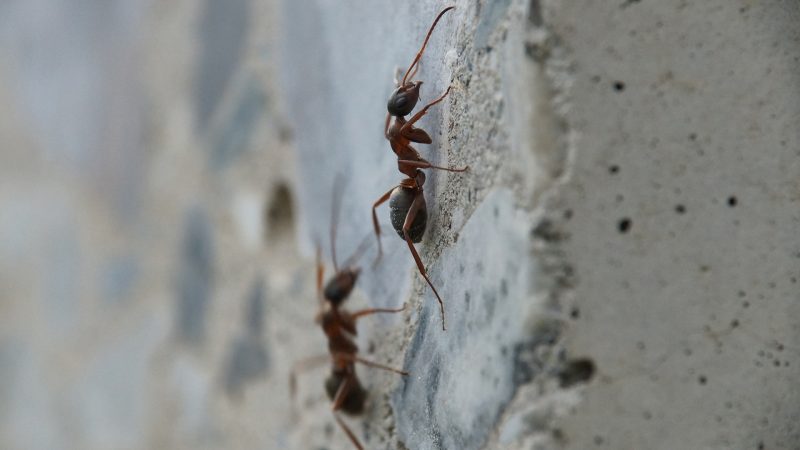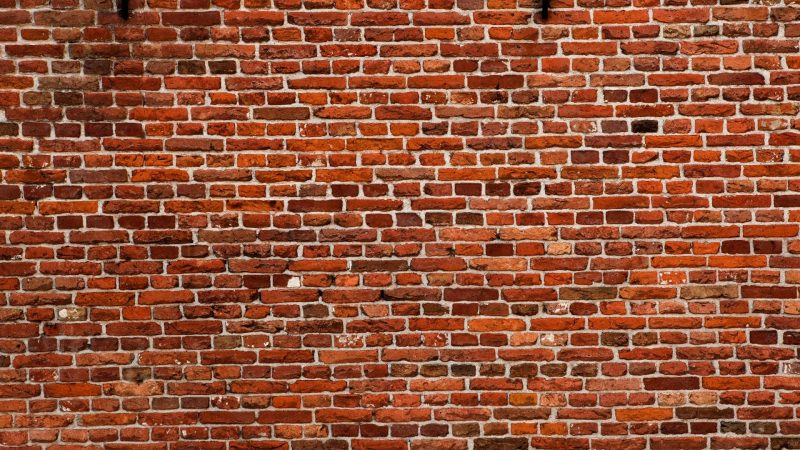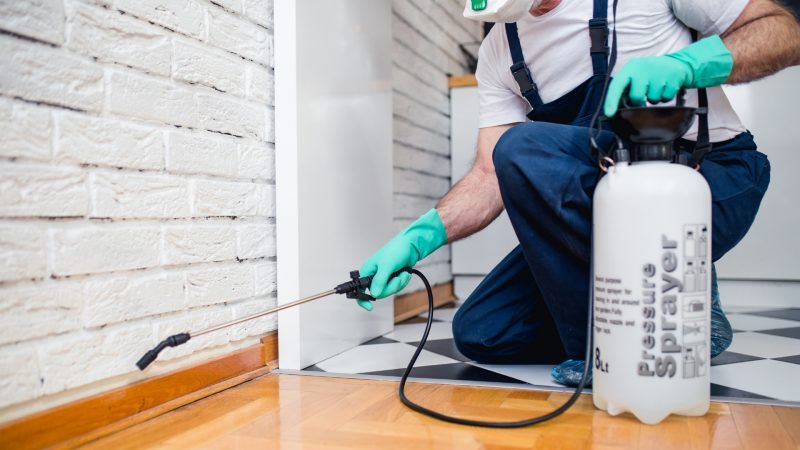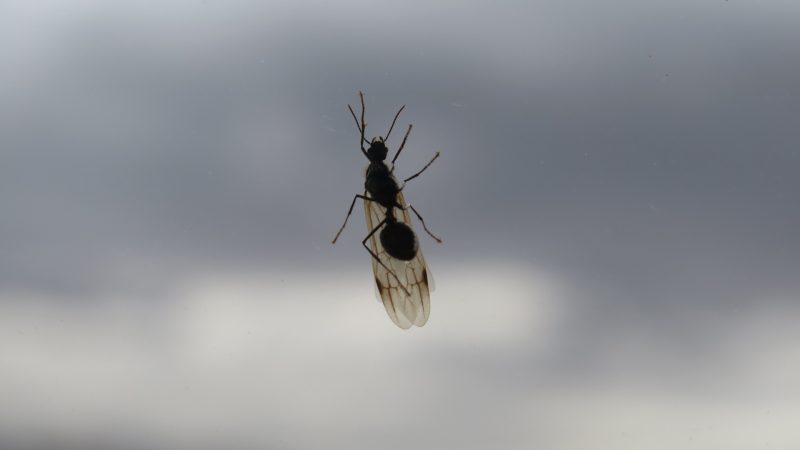Ants can be commonly seen in wall voids or cracks in houses or buildings. They prefer to build their nests anywhere near moist and warm surroundings such as holes and crevices, under kitchen cabinets or plumbings, inside wooden beams, etc. There are thousands of species of ants, every species shows distinct behavior and pattern, and tends to look for safe shelters.
The well-established ant colonies can damage your walls, wooden structures, and cause major health risks. Therefore, the problem of having ant colonies in the walls should be addressed immediately to avoid any major problems in the future.
Exterminating ants in walls is usually done either by ant baits, insecticide dust, or ant spray. Insecticide dust in combination with ant baits is probably the most effective solution. Ant baits can help to lure ants out of their shelter and get rid of their entire colony, while ant dust works as a barrier and keeps your walls safe.
Ant baits are also very helpful when you cannot approach an ant colony. Before applying any methods you first need to identify the type of ant and carefully plan where you will apply the insecticides.
In the following section, we will share the most common types of ants that are seen in your walls and the methods how to get rid of them. In addition, you will also find some natural homemade remedies that work on ants in walls. Let’s begin!
Ants in Walls| Information
There can be several reasons why ants have invaded your property and have established colonies inside their walls. Ants are attracted to warm and moist places where they have easy access to food and water. Wall voids and crevices provide ants with a safe place to develop their colonies.
The most common indoor ants that live in walls are sugar ants, odorous ants, pavement ants, little black ants, Pharaoh ants, acrobat ants, carpenter ants, crazy ants, Argentine ants, etc.
Why Are There Ants Coming Out of the Wall?
Find ants coming out of your wall, it is an indication that your wall has cracks or voids. Ants are attracted to places where they can get easy access to food and water and areas which are warm and moist, this is usually near the sink, water pipelines, damp wooden walls, etc. If you see ants or visible ant trails, look for the entry points and the holes which are attracting them.
Can Ants Live in Walls?

Ants can build their nests at any place where they find favorable environmental conditions. They may be attracted to your house due to harsh weather or by tracking food scents coming out of your house. Spilled juices or other sugar-based foods can easily overnight attract ants into your house.
After getting access to your house, ants will look for safe shelters such as wall voids, holes, or other spaces. Wall cracks are one of the most common spaces where ants prefer to build their nests. Fix the cracks and seal the voids to block the potential nesting sites of ants.
Can You Hear Ants in the Walls?
Ants usually do not make any sound while moving in walls. However, the soft rustling sound of wall-excavating ants can be easily heard. The audible sound is produced when they excavate wooden structures or walls.
Do Carpenter Ants Produce Sound in Walls?
Carpenter ants are notorious for their capability to damage and excavate wood. These ants are attracted to your yards or house due to the presence of damp wooden structures, furniture, wooden shavings, wooden frames, or wall.
If you hear the soft sound coming from wooden walls or beams then the most probable culprits are the carpenter ants. They produce sounds when they move or chew on the wooden walls. To investigate the carpenter ant invasion in the wooden wall, do a slight knock on the wall. The hollow sound is the indication of an infested wooden wall. Take immediate action to avoid further damage to your house.
Do Sugar Ants Live in Walls?
Sugar ants include the group of ants that are attracted to sugar-based foods in your house. These sugar-loving pests are drawn into your house by following the food trails. After getting access to your house, sugar ants look for dark and safe places, cracks or holes to establish their colonies.
They are frequently seen in wall voids or wall cracks near favorable surroundings. The space inside the wall provides them a safe nesting place and a welcoming environment. Look for the entry points and follow the trails of sugar ants to locate their nesting sites and to exterminate them.
Related: How to Get Rid of Sugar Ants in the House: A Complete Guide
Ants in Specific Walls
Ants can be seen anywhere especially near-wall voids, brick walls, bathroom walls, RV walls, etc. If you discover an aggregate of dust, hollow wooden surface, or ant trails, these signs indicate that there is an ant infestation in your walls.
Ants in the Brick Wall

Ants infestation is a common problem under pavements and inside brick walls. They make their nests in the spaces between bricks. If you notice ant trails on the brick wall, take preventive measures before they establish their colonies. The best course of action is to seal all the potential cracks in your brick wall.
Ants in the Shower Wall | Bathroom Walls
As ants prefer to live near warm and moist surroundings such as bathrooms, near leaky showers, inside cracks near water pipelines, sinks, or under bathtubs. This is the best place for the ants to establish their colonies. Ants are attracted to shower walls due to moisture and warmth.
If you see ant trails in your bathroom you should first fix any leaky pipes, seal wall cracks, and keep your bathrooms dry and clean to prevent further ant colonization. After that use insecticide spray, dust or baits to exterminate ants from bathroom walls.
Ants in Exterior Walls
Ants can enter your house through open access points or exterior walls. Vines or trees near exterior walls also act as a bridge for the ants and help them to enter residential areas. Cracks or crevices inside the exterior walls can be potential nesting sites for ants.
If you want to prevent ant infestations in the exterior walls then clear the plants linking your wall to the ground and seal the cracks inside the wall. You can also apply insecticide spray or dust to eradicate larger ant infestations in walls.
Ants in RV Walls
Ants are the most common pests that can easily invade RV walls. This can lead to serious trouble once the ants establish their colonies. They can build their nests inside your RV wherever they find small spaces or holes.
It is necessary to deal with the ant invasion before it starts causing problems. You can use recommended ant-repellent chemicals, traps, or insecticide sprays to get rid of ants from your RV walls. In some cases, you can even place ant-repellent plants inside the vehicle to keep them away. Click on the following link to find out more about how to deal with ants in RV.
How to Get Rid of Ants in Walls: Step by Step Instructions
Ants are considered to be one of the most notorious pests. Small colonies of ants may go unnoticed but larger infestations of ants can lead to serious damage. Timely inspection and treatment can save you a lot of time and money. The eradication of larger ant infestation needs strict measures and an integrated pest management plan.

Step 1: Slowing Down the Ants
Ants are mostly attracted to your house due to the poor hygienic conditions, by following the food trails or in search of a safe shelter to avoid harsh weather outside.
Do not leave food leftovers overnight and take care of the cleanliness. Keep your bathrooms and kitchen area clean and dry. Fix all the broken pipes and seal the cracks and holes in the walls. As the wall voids and cracks are the most common nesting sites of ants. You can minimize the chances of ant infestation by applying these simple prevention tips.
However, if the infestation goes unnoticed at earlier stages then you may have to take strict measures to get rid of ants in the wall. Ants multiply rapidly and can develop their colonies in only a few days. The presence of ant trails or piles of dust is an indication of an ant invasion in your walls.
Step 2: Inspection of the Infested Site
To effectively eradicate the ant colonies in the infested area or in wall voids you should identify what type of ant has infested your wall. There are thousands of ants species and each of them has different behavior and requires different chemicals.
Identify the ant species and investigate the level of infestation to devise an eradication plan. The next step is to select the best eradication method according to the ant type.
Step 3: Pest Control Methods
Liquid Sprays
The most common method to get rid of ants in the wall is with the use of liquid insecticide sprays. This is one of the most effective and efficient methods to eliminate ant invasion. There are multiple ant killer sprays are available commercially. You can buy the best one according to the type of ant species. Ant killer sprays are usually common in two different varieties i.e. contact ant killer and non-repellent insecticide sprays (or residual ant killer).
The contact insecticide sprays instantly kill the ants when they come in contact with ants. This method may not be effective because it will only kill the ants present at the site and causes the remaining ants to move away.
Non-repellent ant killers do not repel the ants and act as invisible deadly killer. It does not instantly kill the ants and allow them to travel back and spread the insecticide in their nests.
Treat all the entry points, trails, and nesting sites with spray and follow the prevention tips to avoid the re-establishment of ant colonies. The following are some of the ant sprays that we recommend:
Ortho Home Defense Insect Killer for Indoor & Perimeter
- Ortho Home Defense Insect Killer for Indoor & Perimeter2 is a bug...
- Provides a long-lasting bug barrier of up to 12 month protection...
- Apply this pesticide anytime as a preventative treatment or after...
- Use this pest control spray with confidence indoors (kitchens,...
- The easy-to-use continuous spray Comfort Wand helps you control...
Hot Shot HG-4480 Ant Killer Plus Aerosol
- KILLS A VARIETY OF ANTS: Kills Argentine, southern, field,...
- KILLS ON CONTACT: Hot Shot Ant Killer Plus aerosol kills on...
- ALSO KILLS COMMON HOUSEHOLD INSECTS: Also kills cockroaches,...
- FOR INDOOR AND OUTDOOR USE: Spray Hot Shot Ant Killer Plus both...
- AEROSOL SPRAY: This water-based, unscented formula leaves no oily...
Raid Ant & Roach Barrier Spray
- Keeps ants, fleas, flies, gnats, roaches, ticks silverfish,...
- Leaves no lingering odor
- Raid Ant & Roach Barrier lays down a line of defense to keep ants...
Insecticide Dusts
Insecticide powders or dust are in our opinion a lot more effective and versatile options than ant sprays. The spray can in some cases leave a stain on the wall and it is hard to apply it inside the cracks. On the other hand, with the use of the duster, insecticide dust can really reach deep inside the cracks and destroy the ants. The following are the best insecticide dusts that you can buy:
Delta Dust Multi Use Pest Control Insecticide Dust
- Delta Dust Bed Bug Insecticide - 1 lb.
- Yield: 1 lb. of Delta Dust covers about 2,000 sq.ft.
- Target Pest: Ants, Bed Bugs, Boxelder Bugs, Cockroaches,...
- Active Ingredient: Deltamethrin, 0.05%
- Cannot ship to NY or CT.
Rockwell Labs CXID032 Cimexa Dust Insecticide
- For control of bed bugs, fleas, ticks, lice, roaches, ants,...
- Kills bed bug adults, nymphs and nymphs hatched from dusted eggs...
- Labeled for treating cracks, crevices, voids, mattresses,...
- Odorless, non-staining desiccant structure will not absorb water...
- Remains viable for up to 10 years when undisturbed
Advance 375a Select Granular Ant Bait
- Uses food attractant ants love
- Works on wide range of ant species
- Easy to apply
- Treatments last several weeks
- Weather resistant
Ant Baits or Ant Traps
Ant baits or traps show the best results in comparison to other pest control methods. Baits are slow-acting but eventually are able to kill the entire colony (including the queen). There are different varieties of bait available commercially i.e. liquid baits, gel baits, and granular ant baits. They can either be protein-based or sugar-based baits, and you can buy them according to the eating behavior of the ant species that has infested your walls.
Some ants prefer sugar-based food whereas others like their food to be protein-based (greasy). Liquid baits are mostly sugar-based, less poisonous, and come in containers. Gel baits (mostly sugar-based) are sold in tubes or syringes, you can apply them on the surface near nesting sites. Granular ant baits on the other hand are mostly solid protein-based baits.
Put these baits near the wall voids, entry points, and at ant trails. The ants will take the bait back to their colony and this whole process will eventually cause their death. You can also do a test with sample bait before application to check the effectiveness of the bait for the specific ant species. Do this in cases when you are not sure about the type of ant you are dealing with. The following are some of the best ant baits that we recommend:
Syngenta – Optigard Ant Bait Gel Box
- Target pests: For indoor and outdoor control of...
- Highly attractive formula promotes ready transfer of the active...
- Powerful, active ingredient knocks out workers, brood and queens
- Approved for use indoors and outdoors, applied in cracks and...
- How does Optigard Ant Bait Gel work? Ants that feed on the gel...
Advance Select Granular Ant Bait
- Uses food attractant ants love
- Works on wide range of ant species
- Easy to apply
- Treatments last several weeks
- Weather resistant
Homeplus Ant Killer Metal Bait Stations
- Ant Bait: Our indoor & outdoor ant killer uses a bait to attract...
- Ant Repellent: This ant trap kills the queen, and effectively...
- Outdoor Ant Traps: These ant bait traps use 4 food based lures to...
- Ant Killer: Our pet-friendly ant bait station easily eliminates...
- Size and Other Details: Replace the ant bait trap every 30 days.
How to Get Rid of Carpenter Ants in Your Walls?
Carpenter ants are one of the most destructive ant species. They live in rotting or damp wooden walls or in other wooden structures. These ants have the ability to excavate wood and build their shelters deep inside. Adult worker carpenter ants are half an inch long and have a brown-to-black appearance.
A mishandled carpenter and infestation can lead to massive structural damage in your house. Keep your house clean and do not leave food particles overnight that can attract carpenter ants to your house. Wipe out excess water to keep your place dry.
To get rid of carpenter ants in the infested walls, identify the nesting sites of ants. After identification and inspection, drill multiple holes of about 1/8 inch near the entry points of carpenter ants to treat the infested area.
Apply non-repellent ant killer sprays or dust in holes to exterminate them. After the eradication, seal all the cracks in the wall and fix any leakage problems to prevent them from coming back.
Related: How to Get Rid of Carpenter Ants Without an Exterminator
How to Get Rid of Flying Ants in Walls?

Flying ants are winged male or female ants that appear for a short time period for mating purposes during the spring or summer season.
Close windows and other entry points that can draw these ants in your house. The infestation of flying ants in wall cavities or wall voids can be treated with insecticide sprays or poisonous sticky traps.
You can also use a vacuum to eradicate swarms of flying ants. Seal all the wall voids and keep your windows and doors closed to prevent them from re-entering.
Related: How to Get Rid of Flying Ants: A Complete Guide
How to Get Rid of Odorous House Ants in Walls?
Odorous house ants are common household ants, they are about 1/8 inch long and have a black or brown segmented appearance. Crushed odorous house ants smell like rotten coconut. Baiting is the most reliable method to get rid of the odorous house ant infestation in your walls.
You can buy different sugar or protein-based baits to lure these ants out of their nests and to exterminate their entire colony. Application of sticky traps and non-repellent ant killers are other effective ways to get rid of them. Fix all the wall voids and holes after the treatment.
How to Get Rid of Pavement Ants in Walls?
Pavement ants are often confused with odorous house ants due to their similar appearance and features. They are brown to black in color and are about 1/8 inch long. The characteristics that distinguish pavement ants from odorous house ants are the presence of two frontal nodes at the abdomen with a cluster of hairs and two spines at the back.
Pavement ants prefer to build shelters in sidewalks, underfloor, in wall voids or cracks, etc. You can apply sugar-based ant baits, ant traps, bait stations, or liquid spray to get rid of pavement ants in walls or cracks.
Follow the trail of ants and inspect their entry points and shelters. After inspection, apply sprays or baits at the infested wall voids and pavements. Gel baits come with ready to use syringe or injection that you can squeeze directly inside wall voids or cracks. Seal the cracks after the treatment of infested sites to avoid their re-establishment.
How to Get Rid of Sugar Ants in Walls?
Sugar ants are a group of ants that are attracted to sugar-based food items such as jams, jellies, juices, crumbs, etc. For example, Pharaoh ants and pavement ants are also referred to as sugar ants due to their fondness for sugar-based food.
The sugar ants are yellow, brown, reddish-brown, or black in color. They enter your house by following the sweet food trails or moisture and build their shelters in narrow spaces or wall voids. You can use different insecticide liquid sprays, ant baits, ant traps, or insecticide dust to get rid of these ants in walls.
How to Get Rid of Ants in the Walls Naturally?

Ant Repellent Plants
Some plants contain essential oils that act as a natural ant deterrent, they can also be used as a barrier to prevent the entry of ants in your house. The most commonly used ant repellent plants are peppermint, cinnamon, bay leaves, catnip, cayenne pepper, black pepper, garlic, etc.
Vinegar Spray
Prepare homemade liquid insecticide spray by mixing vinegar and water in equal parts (1:1). Pour the solution in a spray bottle and treat the trails, doorways, cracks and wall voids with the spray directly.
Peppermint Spray
Add a few drops of peppermint essential oil in water to prepare your insecticide spray. Apply the solution directly in the wall void, holes, and other nesting sites to get rid of ants.
Sugar and Borax Bait
You can prepare homemade sugar bait by mixing an equal amount of sugar and borax. Put the bait near the infested areas and on trails to eradicate ant colonies. You can also add honey or peanut butter in borax to prepare honey or peanut butter bait.
Soap Water Spray
To prepare soap water spray, add 1 part of dishwashing liquid soap in 2 parts of water and mix them. You can directly apply this insecticide spray on the walls and other infested sites.
How Can Ants Walk on Walls?
Ants are excellent climbers, they walk on the walls using tiny hooked claws which are located at the ends of their feet. The hooked claws help ants to cling to the wall. Ant can easily climb on smooth vertical or round surfaces.
However, they cannot walk on Fluon, a product similar to Teflon. This substance is too slippery for the ants to climb. Fluon can be applied on the wall or the pet feeders to keep the ants away.
Summary
Ants are easily attracted to moist and warm environments and will build their shelters in narrow and dark spaces such as wall voids or cracks. Most of the ants do not cause structural damage in the walls but some species of ants (such as carpenter ants or moisture ants) can be extremely destructive for your wooden walls and other wooden structures. They excavate wood to build their shelter, but they do not eat or feed on the wood.
Keep your house dry, and clean, and remove any excess water and damp wood that can lure ants. Mishandled ant invasion can lead to a larger infestation in only a few days. Carefully identify and inspect the infested sites to select the best insecticide for your specific type of ant that is causing you problems.
Several liquid ant killer sprays, ant baits, insecticide dust, or sticky traps are available commercially which can help to eradicate any ant infestation. Natural insecticides also work similarly to synthetic ant killers but are not that effective.
In case you are having a serious ant infestation, it would be best to call a professional pest control service. Click on the following link if you are interested, and you will get free quotes from the best ant exterminators in your area. Best of luck!
Related: How to Get Rid of Ants | Safe and Effective Methods
List of Sources
Potter M., Ant Control for Householders, University of Kentucky College of Agriculture
Sharpe K. & Klass C., Integrated Pest Management for Carpenter Ants, University of Connecticut, College of Agriculture, Health, and Natural Resources
Pavement Ants, Michigan State University
Potter M., Carpenter Ants, University of Kentucky, College of Agriculture, Food and Environment
- How to Get Rid of Copperheads | Practical Guide - August 27, 2023
- How to Get Rid of Corn Snakes | What Makes Them Aggressive? - August 27, 2023
- How to Get Rid of Alligators | Safety Measures and Removal Methods - July 16, 2023









